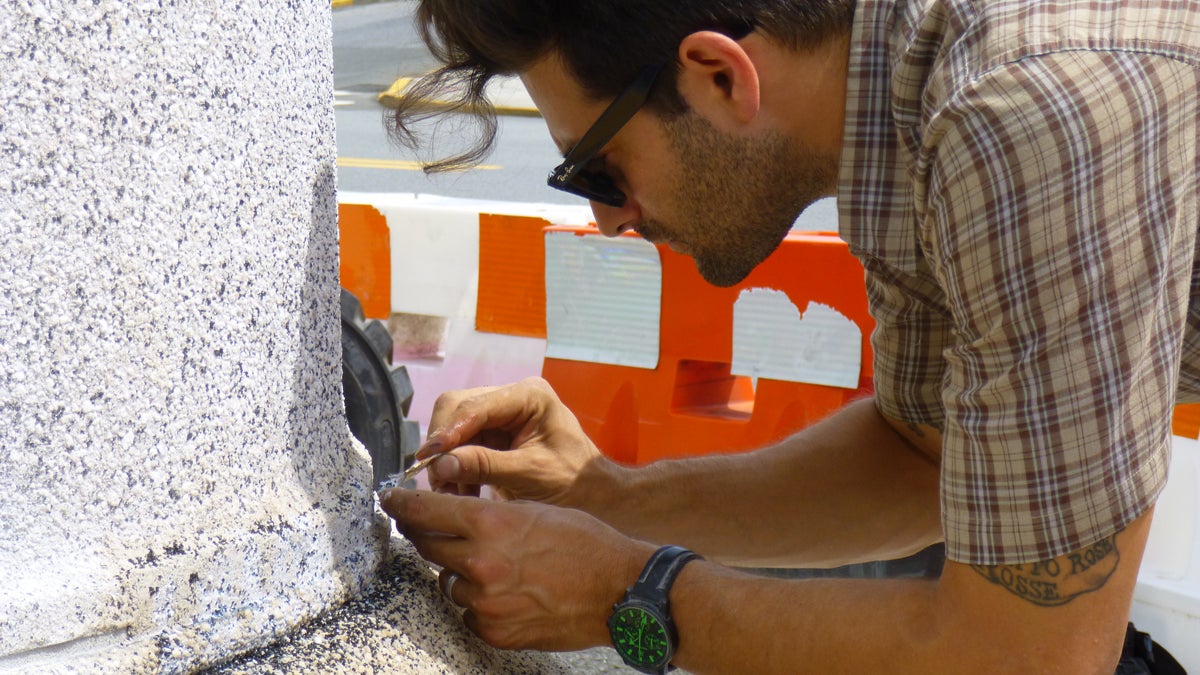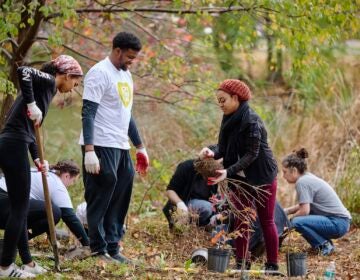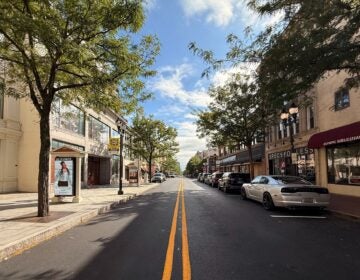Stonemasonry skips a generation to land in a Philly millennial

Marco Federico at work
When Marco Federico talks about his work poking around historical burial grounds and buildings — of which Philadelphia has an abundance — this architectural conservator covers about as wide a range of skills and interests as he covers in actual geographical area in and around Philly.
“Summer’s been busy,” Federico says. “It’s usually more intense because of all the outdoor work.”
Like?
“Burial grounds, especially the older historical ones, where I help conserve and restore the stones. A lot of outdoor sculpture, too, which is kind of what historical cemeteries are. Building ornaments, historic building materials, like trying to determine a particular historic mortar. I mainly work with stone and masonry systems — brick, terracotta, brownstone, limestone.”
The chance to work with things that are old, beautiful, hand-crafted, and outdoors stands in pretty stark contrast to the plight of so many younger adult professionals who are stuck behind various screens all day. Federico’s days bring together manual artisanship, historical sensitivity, and training as a preservationist — but also a personal twist that underlines it all.
“I have a physical connection to things,” Federico says. “I like to touch things, get my hands inside of them, and find out how they work or why they don’t work. So it was more a personal curiosity that suited my desire to be able to work with my hands.”
Masonry is a pretty specific skill, one that’s apparent throughout the historical streets and stories of Philly. It sounded like it came out of the blue to him, since his father was a teacher and his mom a realtor — until we went back one generation further.
“My grandfather — he died right before I was born — he was a mason,” Federico says. “He came here from Italy in 1964 with my father, and was a stonemason, a bricklayer by trade. He worked hard so his son could go to school and not have to work outdoors with his hands like he had. And here I am, working outside with my hands.”
His stonemasonry experience in college became just a teaser for him — it wasn’t enough to work it out here, he felt the call to go back to his grandfather’s artisanal roots.
“After college, there were lots of things going on in my life,” he says. “I always envisioned myself taking a trip across Europe. But I went to Rome, fell in love with it, and had an internship with the Protestant Cemetery in Rome. Before the 1700s, if you were Protestant in Rome and you died, you weren’t permitted to be buried in the city limits. So you were buried with the dogs and lepers and prostitutes, because it was papal law. But then in the 1700s came the grand tour — many well-heeled tourists and royalty ended up dying in and around Rome. Their families convinced the pope to set aside a small parcel of land for Protestants.”
The Italian flavor took him even more deeply into the specific stonemason craft. “I was always drawn to stone. Never knowing my grandfather, but knowing it was his art, it had a draw to it for me. Modern construction doesn’t have buildings out of stone. They’re more likely a stone veneer on an iron-framed building. So there was a romanticism about it, that it seemed like a lost art.”
From his time in Italy, Federico decided to return to his own homeland (Philly) to take it to the next level. He got a master’s degree in historic preservation from the University of Pennsylvania and moved into his current work from there.
Yet what’s fascinating about Federico’s work is that it’s both preservation and functionality. Something can’t just look pretty — it has to work, which can sometimes feel like a pickle to a preservationist.
“A large part of what I do is to determine failure modes, why things fail, and to come up with a strategy to restore historic integrity but also have to make it work. It has to be functional, it can’t just look good. The challenges in my work are mostly in that tension: compatibilities between materials and solving problems in the physical world, not the inner world. Like, a design flaw in a building can be a 300-year-old design flaw, so often times to fix the flaw could result in changes the historical integrity. The biggest challenge is finding the balance between functionality and aesthetics.”
And for someone with Italian roots, who worked in Rome , is there anything in the upcoming papal visit that intersects with his work?
“To be sure, there are sites around the city that way to put on their best face. So we’ve had a lot of touching things up, putting a new coat of wax on outdoor bronzes, treating the outdoor marbles with biocides, getting things to work. As a Catholic, I’d be honored to work on more outdoor sculpture and architecture owned by the Roman Catholic Church, but the opportunity hasn’t yet presented itself.”
And as a church member, not as a worker?
“I’m excited about it,” he says. “I would love to take my 18-month old son to the mass.”
WHYY is your source for fact-based, in-depth journalism and information. As a nonprofit organization, we rely on financial support from readers like you. Please give today.




